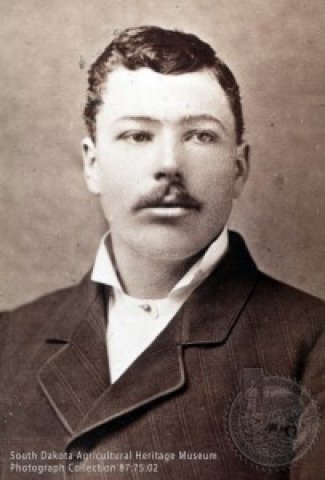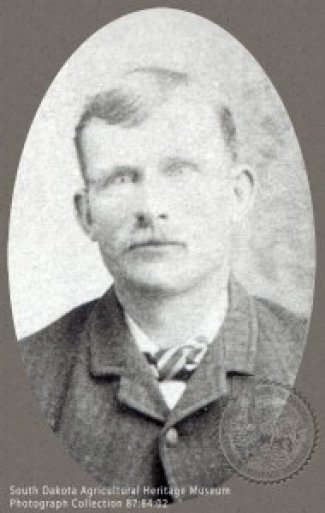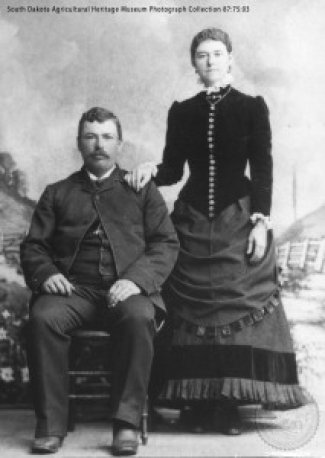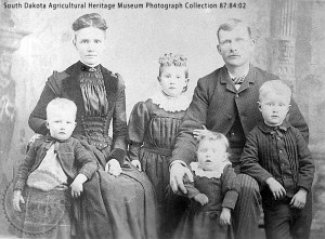Excerpts from The Schanck Family History By Edna Florence Schanck Halligan 1986
CHAPTER II
How They Met
page 15

“About 1879 there were newspapers from Peoria, Illinois, with much general and United States news. There had been much advertising about Dakota Territory land for homesteads. This thought of owning land just by breaking ten acres and building a dwelling, then living on it for a year, was filling the minds of young men who wanted adventure. Also, to own land had been the desire and aim of generations for centuries. People thought their security and sustenance were insured by owning land, so to get land as a homestead was a beautiful dream come true.
John (Schanck), Jr., my father, was of age and he wanted to strike out on his own. He and a neighbor, Joe Hodges, made their plans to go seek their fortunes. Mother and Father had become sweethearts by this time and an understanding that when he came back again, they would marry. Grandmother Schanck was a little unhappy that her son wasn’t satisfied to stay there in Illinois and farm; however the men prepared to leave.

They engaged a railroad car for a team of Father’s horses and a team of Hodges’ mules. They packed their trunks, said good-bye to relatives and started on a journey, they knew not what would be ahead. Their train trip lasted four days. Not having much money, they did everything possible to stretch what they did have. They had some food in a lunch box, expecting to get more when the freight cars were changed to a different railroad. How many changes they made I do not know. From Wyoming, Illinois, to Dakota Territory was a long way. The railroad came to Egan and at this point a new branch was built west. When they got to DeSmet that was the end of the line for them.
Father’s story of their trip portrays how frugal they were. The owner of livestock could ride in the stock car and care for the animals and the fare charged was only the freighting for the animals. After some discussion Joe was to ride in the stock car. Father rode in the caboose. If you have ever been inside a caboose you can understand what a dismal and dirty long ride that was. The coal burning engine belched out black smoke and soot all the way, no place to wash or shave. When the brakeman saw how weary Father was and learned where they were traveling to, he let him ride a short way in the chair car. On getting off the train, Father was feeling and looked pretty tousled, but Joe looked and smelled much worse after sleeping in the straw with the mules. They now were on Dakota Territory and it was time to look over their surroundings.
DeSmet was a typical prairie settlement. In the spring of 1880 the Dakota Central railroad, a division of Chicago and North Western, had pushed westward from the winter terminus at Volga, to the town of Huron, on the James river. Little villages at irregular intervals had sprung up. Nordlund, later called Arlington; Lake Preston; DeSmet; Manchester, once called Fairview; Iroquois; and Cavour were small settlements. Some of these were a couple of stores, a rooming house, livery stable and a claim shack or two close by. Settlers came in great numbers from eastern United States and Europe, many arriving aboard crude and creaky railroad cars pulled by woodburning, huffing and puffing locomotives. Others came by foot or by ox drawn covered wagons and horseback.
A number of pioneers made igloo-like houses in side hills or built sod houses if they had a way to plow up the sod.
DeSmet now had two hotels, a feed store, livery stable, grocery, and a few professional people were there to make contracts with the new homesteaders.
The railroad had given quarter sections of land along the railroad line to people who would come and settle there, for if there was no freight to haul, there would be no business. That was how people got interested in coming to this vast prairie.
In the spring of 1880 Father and Joe Hodges arrived at DeSmet. It was cold yet, and their stock had to be kept at the livery barn, and as soon as the land men could take them out to see different parts still available for the homesteading they would go take a look. When they left Illinois the spring was almost there, but not so in this climate; this delayed their starting to work.
This waiting was really trying on them, and several times they were about to try for tickets back home again. There was no problem, they could easily sell their horses and mules to raise money for their tickets. Finally, they were driven out in a buggy by a man from the homesteader’s office to choose a new home. It was seventeen miles across country before they came to unclaimed land. One quarter was square and the other was two eighties adjoining. They tossed a coin to see which land each would claim. They returned to DeSmet and the next day loaded a wagon with lumber, plows, feed for the stock, their trunks and food.
It was certainly a new experience for them and the thought entered their minds, “Can we find our way back there again?”. No trees, no fences, just extremely tall grass, hills and hollows. Here and there in the distance a column of smoke could be seen coming from a settler’s home. These were the only signs that directed them and relieved the feeling that they weren’t entirely alone in the vast grasslands. The surveyors were accommodating, and would help newcomers. This area was surveyed, but not made into counties. People had so little, having a neighbor was really a good fortune.
At least they were ready to work, and work they did, from early mornings until dark. The livestock was picketed and they slept in the wagon. Each day their houses became more like a claim shack. It took several trips for lumber before they had a place to call shelter. This claim shack was taken to the state fair at Huron, South Dakota many years later, and is still preserved as Brookings, South Dakota as an historical object early settlement.
The requirements to get title for a homestead were: They must live on the land a year, break up ten acres, and build a dwelling. After the summer they complied with most all, except, to qualify for a separate dwelling they had to put a partition and an extra door in the house and this passed for a dwelling for each quarter.
Father did not like to cook very well, so he made a deal with Joe; if Joe would cook, he would plow so many days. Agreed, so, day by day they worked. We liked to ask our father what they had to eat, he said, “mainly potatoes, salt pork and flapjacks”. He would tell how they boiled a big kettle of potatoes and stored them under the bed, then when they came in from following that walking plow and gee and hawing the team through grass that was belly high on the horses, they were so tired and hungry they peeled the mold from their “stored under the bed potatoes” and fried them. Maybe they got some penicillin from this, ha!, at any rate, they didn’t get sick.
My father was a chubby boy, a robust young man, and fat by the time I was born. He had very dark wavy hair, blue eyes, rather small bones and got to weight 250 pounds. He was five feet eight and a half inches tall. He always had been sort of fat. Mother thought a fat man indicated he was amply fed, which wasn’t bad. She was not as small boned accordingly for a woman, as he was for a man. All the family had small feet except me, mine were average. As a child this bothered me. When I grew up, it seemed my feet went quite well with the rest of me.”
CHAPTER IV
A Pioneer Home
page 27

“I can remember quite a little from age five on, also so much our parents told us of their lives earlier. After our parents were married, they lived one year near Grandmother Schanck on a farm across the road. Then Father came back to his claim and built a 14×16 foot shack so they would have a house when Mother came.
While Father was in Illinois, Joe Hodges had moved their clam shack on to his quarter. He must have married almost at once, for when John got back, Joe had two children, Abbie and Ray.
This time Father brought a team and a cow, got this house built, and in February Mother arrived by train at DeSmet, in the worst blizzard possible. She would tell us, “The good Lord was watching over me”. When the train stopped the conductor helped her off with her bags and signaled for the train to go on right away. The depot agent didn’t come out, and snow was blowing and whirling so bad she couldn’t see anything; except there had been a tiny light when she first got off. It was very frightening, such a storm she had never known of. She kept her direction where that tiny light had been and wallowed in the snow until she felt the side of a building, then finding the window where that tiny light had come from, she pounded with all her might. The agent heard the pounding and went to see what it was. He was astonished to find a woman out there. He got her in by the stove and again and again apologized for not coming out those few minutes the train had stopped. She could easily have frozen to death. The train had been in such trouble the year before by snow banks, that stopping long might mean being stalled for months.

The next day the agent helped her to the hotel. There were two; he suggested a certain one for ladies, drifters and rough travelers came to the other one. She had written Father when she would arrive, but the weather was so bad she stayed at the hotel three days before he came for her. That waiting was long. The second day she asked the hotel proprietor if she couldn’t help. He was more than happy. He put her into making beds, peeling potatoes and assisting with everything. She didn’t want any pay. He insisted on giving her a few dollars and said, “Any time, if you need work, we will hire you”. John Sturgeon and wife Zoe were the owners of the hotel.
To find the way back to claim amazed Mother, she kept asking Father how he knew that way. He assured her they would find their place. Her new home wasn’t anything to marvel at. It was 14×16 foot shack with a loft.
Winter was a hardship none of us can realize. They never were warm. When washing dishes, the spatters which went on the floor froze at once. Mother wore her overshoes all day long. When they were short of fuel they twisted hay for many weeks. Their mits wore out so fast from the roughness of this prairie hay and their hands became cracked. They kept kegs of nuts in the loft to crack; this helped pass time.
Even summer had its hardship; no shade from trees or streams near. The well held out so they had water for themselves and the animals.”

